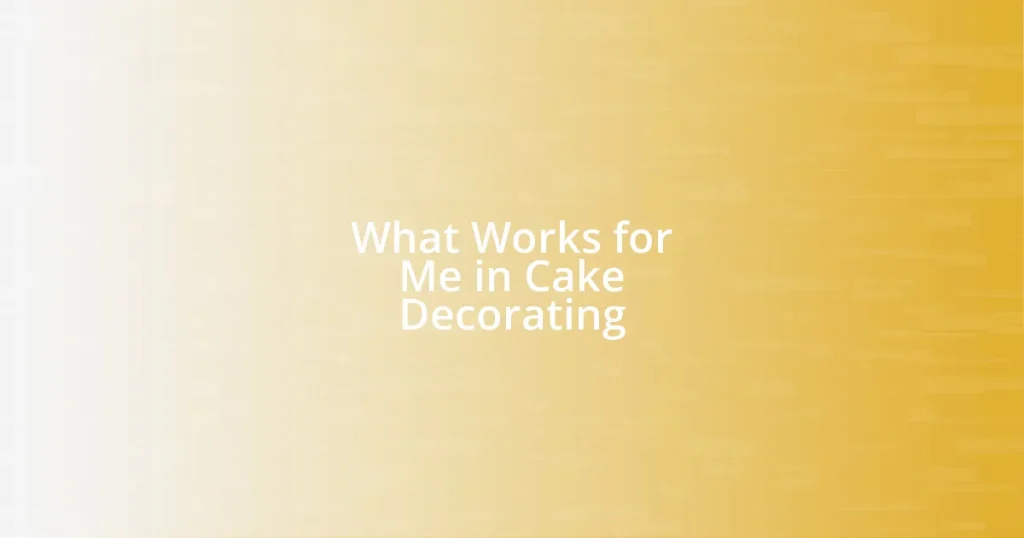Key takeaways:
- Essential tools for cake decorating include an offset spatula, piping bags and tips, and a turntable for smoother results.
- Mastering basic techniques, such as leveling and crumb coating, is crucial for a polished final cake appearance.
- Understanding color theory enhances cake design by creating visually striking combinations that evoke different emotions.
- Avoid common mistakes like poor preparation and overloading decorations to ensure a clean and elegant cake finish.

Essential Tools for Cake Decorating
When it comes to cake decorating, having the right tools can make all the difference. I remember the first time I tried to decorate a cake with just a spatula; it was a disaster. Investing in a good offset spatula transformed my decorating game. It allows me to smooth out frosting effortlessly and reach every corner of the cake—such a simple tool yet so impactful!
Another essential tool I can’t live without is a set of piping bags and tips. Let’s face it, who doesn’t love the elegance of piped frosting? I once spent hours trying to replicate a piping design using a plastic sandwich bag because I wanted to save a few bucks. Spoiler alert: it didn’t work! The right piping tips not only bring my vision to life but also save me time and frustration. Plus, they allow for creativity—I love experimenting with different tips to see what unique designs I can create.
Lastly, a turntable is an absolute game-changer. Do you ever feel like your back is screaming after decorating a cake by leaning over it? Trust me, I’ve been there. Once I started using a turntable, my decorating became smoother and more enjoyable. It allows me to rotate the cake easily and ensures even coverage all around. The joy of seeing a beautifully decorated cake spin before me is hard to put into words!

Basic Techniques for Beginners
To get started in cake decorating, mastering basic techniques is essential. One of the first skills I focused on was leveling my cakes. It may sound simple, but leveling a cake ensures an even base that makes all the difference in the final look. The first time I skimped on this step, my cake leaned dangerously to one side, creating a lopsided disaster that still haunts me!
Another fundamental technique I found invaluable is crumb coating. I can’t stress enough how this step prepares your cake for a flawless finish. Initially, I was nervous about creating a perfect crumb coat, but it’s essentially a thin layer of icing that traps any stray crumbs. After a bit of practice, I realized that this method not only smooths out imperfections but also gives your cake a polished look.
Here’s a quick list of techniques to kickstart your journey:
- Leveling: Use a serrated knife to trim the top of your cake for an even surface.
- Crumb Coating: Apply a thin layer of frosting to seal in crumbs before the final coat.
- Smooth Frosting: Use an offset spatula or a bench scraper to achieve a smooth finish on your cake.
- Piping Basics: Practice the pressure control needed for piping designs by trying different techniques on parchment paper.
- Fondant Application: Learn how to roll and drape fondant smoothly by kneading it well to prevent cracks.
Getting comfortable with these techniques not only boosts your confidence but also leads to stunning results as you progress in your cake decorating journey.

Color Theory in Cake Decorating
Color is a powerful tool in cake decorating, and understanding color theory can elevate your creations to a whole new level. I vividly recall the moment I discovered the impact of color contrast. I had baked a simple vanilla cake but adorned it with a vibrant purple frosting. The immediate reaction from my friends was overwhelming! They were drawn to the cake not just by its flavors but by its eye-catching visual appeal. It taught me that sometimes, it just takes one bold color to transform an ordinary cake into a stunning centerpiece.
When exploring color combinations, I often think of the color wheel, a handy reference that helps in selecting harmonious or contrasting colors. I learned early on that complementary colors—those opposite each other on the wheel—can make a cake visually striking. For instance, pairing orange and blue can create a lively design. One time, I used this theory when decorating a birthday cake for my niece, combining bright pink and green. The result was dazzling, and her excitement was priceless when she saw her vibrant cake!
To further enhance my understanding of color dynamics, I pay attention to the emotions that different colors evoke. For instance, warm colors like red and yellow tend to evoke energy and joy, perfect for celebration cakes. On the other hand, cooler colors like blue or green can bring calmness, ideal for more elegant occasions. Reflecting on past experiences, I remember how a deep blue cake filled with lavender frosting not only looked classy but also left guests feeling serene and pleased.
| Color Scheme | Example Colors |
|---|---|
| Complementary | Red & Green |
| Analogous | Blue, Blue-Green, Green |
| Triadic | Red, Yellow, Blue |

Creating Textures and Patterns
Creating textures and patterns brings a cake to life, transforming it from a simple dessert into a stunning work of art. One technique that I absolutely love is using a spatula to create swirls or patterns in the frosting. I remember the first time I tried it—my heart raced with excitement as I pulled the spatula through the icing, revealing smooth ripples. It felt like painting, and the resulting texture added such depth, I couldn’t believe it was the same cake I had started with!
Another method I’ve found effective is using stencils to create intricate designs. During one baking spree, I decided to stencil on a lace pattern for a wedding cake. It took focus and precision, but seeing the final product made the effort worthwhile. The delicate patterns added elegance, and guests were constantly admiring the detail as they took their first bites—talk about a win!
I also enjoy experimenting with different materials and tools for texture; for instance, using a pastry comb gives a unique finish that’s satisfying to both create and admire. Have you ever felt that rush when you realize the texture you’ve just created is exactly what you envisioned? That sense of accomplishment is what keeps me motivated to try new patterns and techniques! The tactile feedback from manipulating frosting in various ways is genuinely exhilarating, making each cake an exciting adventure.

Advanced Techniques for Unique Designs
One advanced technique that I find particularly rewarding is using sugar veil or isomalt to create delicate designs. I remember the first time I tried my hand at pulling sugar; it was a bit daunting but incredibly satisfying. As I worked the heated sugar, I felt a rush of creativity—what started as a globby mass transformed into elegant, whimsical shapes that seemed to float above the cake. This technique not only adds a unique focal point but also impresses guests; who doesn’t love a dessert that incorporates a bit of theatre?
Another method that has truly elevated my cake decorating skills is airbrushing. When I first purchased my airbrush machine, I was skeptical about its potential. However, I quickly discovered how easily it can create stunning gradients and visual depth. I once designed a cake that transitioned from a soft pastel pink at the base to a rich, deep purple at the top. The transformation was magical! It’s like adding a whole new layer of artistry—who wouldn’t want to experiment with blending colors in such an interactive way?
Lastly, I’ve fallen in love with incorporating edible flowers into my designs. One time, I decorated a simple lemon cake with vibrant, edible pansies and nasturtiums from my garden. The burst of color was beautiful, but the best part was the conversation it sparked at the table. People were fascinated not only by how it looked but also by the thought of nature’s beauty being part of a celebration. By infusing these natural elements, I find that cakes become not just desserts but conversations starters, don’t you think?

Tips for Professional Finishing
One critical aspect of achieving a professional finish is ensuring my frosting is at the perfect consistency. I recall a time when I rushed through the process and ended up with runny icing that slid right off the cake. It was a frustrating moment, but now I always take the time to whip my buttercream until it’s light and fluffy, checking the texture thoroughly before decorating. Have you ever experienced that frustration? Getting it right transforms the cake and makes all the difference in the finished look.
Another game-changer for me has been investing in good quality tools, particularly offset spatulas and smoothers. I remember admiring finished cakes at bakeries, wondering how they achieved such clean edges. It wasn’t until I switched to an offset spatula that I realized how much it impacted my results. This simple tool allows me to glide across the surface, leading to sharp, precise lines that give my cakes that desired bakery-style finish. What tools have you found that elevate your cake decorating?
Finally, never underestimate the power of a simple finishing touch, like a decorative border or a sprinkle of edible glitter. I once topped a small chocolate cake with a gold luster dust, and it transformed the entire dessert into a showpiece! Adding these little details makes my cakes feel special and invites compliments. Each time I finish a cake this way, I think to myself—what small enhancement can I add to elevate it, and how will it delight those who get to enjoy it?

Common Mistakes to Avoid
One mistake I often see beginner decorators making is underestimating the importance of preparation. I remember the excitement of diving into a cake project without double-checking my ingredients. Halfway through decorating, I found myself missing key elements, which turned my enthusiasm into a chaotic scramble. It taught me a valuable lesson: having everything ready and organized can prevent unnecessary stress and ultimately lead to a better result.
Another common pitfall is overloading cakes with too much frosting or decoration. I’ve been there, thinking “more is better,” only to realize the final product looked cluttered rather than polished. One time, I added layers of fondant, icing flowers, and an array of sprinkles, but it just felt overwhelming. Now, I prefer to keep designs simple and balanced, making each element stand out—after all, isn’t it better to have a few beautiful details than a chaotic mess?
Lastly, a frequent oversight is neglecting to chill the cake before decorating. I vividly recall a time when I applied frosting to a warm cake, only to see it melt and slide off. It was a frustrating struggle to fix that, and it stick with me. Now, I always chill my cakes, allowing the layers to stabilize. This simple step not only makes the application smoother but also enhances the final presentation—what could be more satisfying than seeing your hard work come together beautifully?















